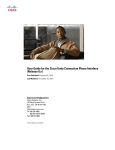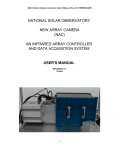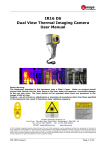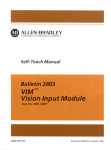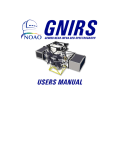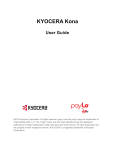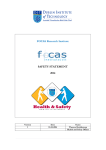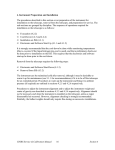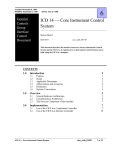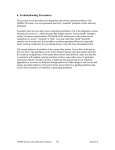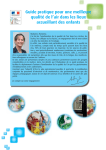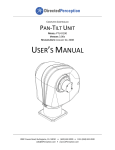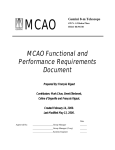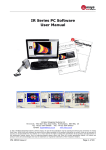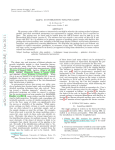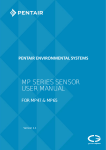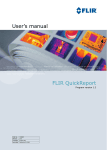Download Functional Performance Requirements Document
Transcript
DEPARTMENT OF ASTRONOMY The University of Wisconsin-Madison [email protected] 475 N Charter Street Madison Wisconsin 53706-1582 Telephone: (608) 262-3071 FAX: (608) 263-6386 http://www.astro.wisc.edu Date FUNCTIONAL AND PERFORMANCE REQUIREMENTS DOCUMENT Andrew Sheinis University of Wisconsin at Madison Astronomy Department Revision History Revision No. Revision 1 Author & Date Approval & Date Andrew Sheinis July 7 2008 Description Original document. Page 1 of 34 DEPARTMENT OF ASTRONOMY The University of Wisconsin-Madison Contents 1 Purpose ....................................................................................................................... 7 2 Applicable Documents................................................................................................ 7 3 Introduction................................................................................................................ 8 4 Optical Requirements ................................................................................................ 9 4.1 Science Requirements............................................................................................... 9 4.1.1 Field Size ......................................................................................................... 9 4.1.2 Wavelength Coverage ...................................................................................... 9 4.1.3 Spatial Resolution ............................................................................................ 9 4.1.4 Spectral Resolution .......................................................................................... 9 4.1.5 System Sensitivity ............................................................................................. 9 4.1.6 Scattered Light Level........................................................................................ 9 4.1.7 Ghost Images ................................................................................................... 9 4.1.8 Polarimetry...................................................................................................... 9 4.1.9 Calibration..................................................................................................... 10 4.2 Image Quality and Optical Tolerances ................................................................... 10 4.2.1 RMS spot size................................................................................................. 10 4.2.2 Alignment....................................................................................................... 10 4.2.3 Focus ............................................................................................................. 10 4.3 Baffling.........................................................................Error! Bookmark not defined. 4.3.1 Optical Baffling.................................................. Error! Bookmark not defined. 4.4 Internal Instrument Background ........................................................................... 10 4.4.1 System Emissvity ................................................ Error! Bookmark not defined. 4.4.2 Background due to Dust on Entrance Window................................................ 10 4.5 Throughput............................................................................................................. 10 4.5.1 System Efficiency ........................................................................................... 10 4.5.2 Filters ............................................................................................................ 11 4.6 General Optical Requirements ............................................................................... 11 4.6.1 Cold Stop ....................................................................................................... 11 4.6.2 Coatings......................................................................................................... 11 4.6.3 Pre-Dewar Thermal Environment .................................................................. 11 4.6.4 Vacuum Environment ..................................................................................... 11 4.6.5 Thermal Cycling............................................................................................. 11 5 Detector Requirements............................................................................................. 12 5.1 Science Detector Performance Requirements......................................................... 12 5.1.1 Detector Read Noise ...................................................................................... 12 5.1.2 Dark Current ................................................................................................. 12 5.1.3 Stability.......................................................................................................... 12 Andrew Sheinis Page 2 of 34 05/13/09 DEPARTMENT OF ASTRONOMY The University of Wisconsin-Madison 5.2 Science Detector Requirements .............................................................................. 12 5.2.1 Detector Format............................................................................................. 12 5.2.2 Characteristics............................................................................................... 12 5.2.3 Mechanical Interface...................................................................................... 12 5.2.4 Thermal Interface........................................................................................... 13 5.2.5 Optical Interface ............................................................................................ 13 5.2.6 Electrical Interface ........................................................................................ 13 5.3 Science Detector Controller.................................................................................... 13 5.3.1 Mechanical Interface...................................................................................... 13 6 Mechanical Requirements........................................................................................ 14 6.1 Rigidity ................................................................................................................... 14 6.1.1 Alignment of the Instrument to the Telescope Optics ...................................... 14 6.1.2 Movement of Spectra on the Detector............................................................. 14 6.2 Mechanical and Thermal Tolerances..................................................................... 14 6.3 Thermal Performance ............................................................................................ 14 6.3.1 Temperature Gradients .................................................................................. 14 6.3.2 Thermal Transients ........................................................................................ 14 6.4 Space Requirements ............................................................................................... 14 6.4.1 Electronic Enclosures .................................................................................... 14 6.4.2 Access to Electronic Enclosures ..................................................................... 14 6.4.3 Access to Cooling Water Ports ....................................................................... 14 6.4.4 Access to Dry Air Ports.................................................................................. 14 6.4.5 Mechanical Connections ................................................................................ 15 6.5 Mass and Center of Gravity Requirements............................................................. 15 6.5.1 Total Mass ..................................................................................................... 15 6.5.2 Center of Gravity ........................................................................................... 15 6.5.3 Balance Tolerance ............................................. Error! Bookmark not defined. 6.5.4 Ballast Weight................................................................................................ 15 6.6 Cryogenic Cooling System...................................................................................... 15 6.6.1 Cool Down Time ............................................................................................ 15 6.6.2 Warm Up Time............................................................................................... 15 6.6.3 Thermal Stability of cryogenic Dewar ............................................................ 15 6.6.4 Thermal Stability of Pre-Dewar ..................................................................... 15 6.6.5 Vibration........................................................................................................ 16 6.7 Vacuum System ...................................................................................................... 16 6.7.1 Staging and Holding Areas............................................................................. 16 6.8 Operational Requirements for Mechanisms ........................................................... 16 6.8.1 Safety ............................................................................................................. 16 6.8.2 Time to Function............................................................................................ 16 6.8.3 Repeatability of Configuration ....................................................................... 16 6.9 Instrument Handling.............................................................................................. 16 6.10 Metric Dimensioning............................................................................................ 16 6.10.1 Metric Dimensions on Drawings .................................................................. 16 Andrew Sheinis Page 3 of 34 05/13/09 DEPARTMENT OF ASTRONOMY The University of Wisconsin-Madison 6.10.2 Metric Fasteners .......................................................................................... 16 7 Control System Requirements ................................................................................. 17 7.1 Operability .............................................................................................................. 17 7.2 Configuration Time ................................................................................................ 17 7.3 General Control System Requirements................................................................... 17 7.3.1 Impact on Mechanism Accuracy..................................................................... 17 7.3.2 Impact on Scientific Performance................................................................... 17 7.4 Temperature Control .............................................................................................. 17 7.4.1 Detector Temperature .................................................................................... 17 7.4.2 Cryogenic Dewar Optical Elements Temperature.......................................... 17 7.4.3 Pre-Dewar Optical Elements Temperature.................................................... 17 7.4.4 Limiting Rate of Temperature Change-cryogenic Dewar................................ 17 7.4.5 Limiting Rate of Temperature Change-Pre- Dewar ........................................ 17 7.4.6 Speeding the Warming Up Change-cryogenic Dewar ..................................... 18 7.4.7 Speeding the Warming Up Pre- Dewar........................................................... 18 8 Electrical and Electronic Requirements.................................................................. 19 8.1 Electronic Design Requirements ............................................................................ 19 8.1.1 Grounding and Shielding ............................................................................... 19 8.1.2 Electrostatic Discharge.................................................................................. 19 8.2 Cable Wrap Interfaces............................................................................................ 19 8.3 Temperature Monitoring ........................................................................................ 19 8.3.1 Temperature Sensor Locations ....................................................................... 19 8.3.2 Temperature Sensor Interfaces....................................................................... 19 9 Software Requirements............................................................................................ 20 9.1 Software Design Requirements............................................................................... 20 9.1.1 Use of RSS-VIS Controller Software Package ............................................... 20 9.2 SALT Furnished Software...................................................................................... 20 9.3 Engineering Interface ............................................................................................ 20 9.3.1 User Interface ................................................................................................ 20 9.3.2 Command and Control ................................................................................... 20 9.3.3 Data Capture ................................................................................................. 20 9.4 Data Processing...................................................................................................... 20 10 External Interfaces ................................................................................................. 22 10.1 Payload Interfaces ................................................................................................ 22 10.1.1 Instrument Support Structure Interface......................................................... 22 10.1.2 Dry Air Interface.......................................................................................... 22 10.1.3 Electric Power Interface............................................................................... 22 10.1.4 Cooling Water Interface ............................................................................... 22 10.1.5 Signal, Control, and Data Interfaces ............................................................ 22 10.1.6 Dry Air Interface.......................................................................................... 23 Andrew Sheinis Page 4 of 34 05/13/09 DEPARTMENT OF ASTRONOMY The University of Wisconsin-Madison 11 Environmental Requirements................................................................................ 23 11.1 Altitude Environment ........................................................................................... 23 11.1.1 Transportation Altitudes............................................................................... 23 11.1.2 Storage Altitudes.......................................................................................... 23 11.1.3 Operation Altitudes ...................................................................................... 23 11.2 Temperature Environment ................................................................................... 23 11.2.1 Operational Environment............................................................................. 23 11.2.2 Survival Environment................................................................................... 23 11.2.3 Transport Environment ................................................................................ 23 11.3 Humidity Environment......................................................................................... 24 11.4 Vacuum Environment .......................................................................................... 24 11.4.1 Creating the Vacuum.................................................................................... 24 11.4.2 Vacuum Quality and Duration...................................................................... 24 11.5 Mechanical Environment ..................................................................................... 24 11.5.1 Telescope Slew Rates ................................................................................... 24 12 Other Requirements............................................................................................... 25 12.1 Documentation ..................................................................................................... 25 12.1.1 User’s Manual ............................................................................................. 25 12.1.2 Service and Calibration Manual................................................................... 25 12.1.3 Software Maintenance Manual..................................................................... 25 12.1.4 As-Built Drawings........................................................................................ 25 12.1.5 Drawing Standards ...................................................................................... 25 12.1.6 Drawing Numbering System ......................................................................... 25 12.1.7 Drawing Filing System................................................................................. 25 12.2 Training................................................................................................................ 25 12.3 Reliability.............................................................................................................. 25 12.3.1 Downtime..................................................................................................... 26 12.3.2 Spares .......................................................................................................... 26 12.3.3 Continuous Duty .......................................................................................... 26 12.4 Maintainability and Serviceability ........................................................................ 26 12.4.1 Standard Components .................................................................................. 26 12.4.2 Modularity ................................................................................................... 26 12.4.3 Access .......................................................................................................... 26 12.4.4 Alignment..................................................................................................... 26 12.4.5 Relative Equipment Arrangements................................................................ 26 12.4.6 Handling ...................................................................................................... 26 12.5 Lifetime................................................................................................................. 26 12.6 Materials............................................................................................................... 27 12.6.1 Toxic Products and Formulations................................................................. 27 12.7 Electromagnetic Radiation ................................................................................... 27 12.7.1 Electromagnetic Radiation Generation......................................................... 27 12.7.2 Susceptibility to Electromagnetic Radiation ................................................. 27 Andrew Sheinis Page 5 of 34 05/13/09 DEPARTMENT OF ASTRONOMY The University of Wisconsin-Madison 12.8 Workmanship ....................................................................................................... 27 12.9 Safety .................................................................................................................... 27 12.10 Human Engineering........................................................................................... 27 13 Appendices.............................................................................................................. 28 13.1 List of Acronyms................................................................................................... 28 13.2 Requirements Tabulation ..................................................................................... 29 Andrew Sheinis Page 6 of 34 05/13/09 DEPARTMENT OF ASTRONOMY The University of Wisconsin-Madison 1 Purpose The SALT Robert Stobie Spectrograph NIR (RSS-NIR) Operational Concept Definition Document (OCDD; DOCNUMBR) defines the scientific requirements of the RSS-NIR instrument and describes operational scenarios. These are translated into technical requirements in the RSS-NIR Functional and Performance Requirements Document (FPRD). Other technical requirements for SALT facility instruments derive from the RSS-NIR Conceptual Design Study Statement of Work. The scientific and technical requirements are summarized in this FPRD, and their relationships are identified so that all functional and performance requirements can be traced from top-level science requirements. The two purposes of the RSS-NIR FPRD are to provide the SALT scientific community with an understanding of what RSS-NIR will do and how quickly or how well it will do it, and to provide engineers with the requirements on which to base the RSS-NIR design. The design is derived from this document. This document takes precedence over other design and fabrication documents. The design must serve the requirements in this document completely. Every feature of RSS-NIR should be traceable to a requirement in this document, and there should be no features of RSS-NIR that are not required by this document. RSS-NIR will be designed in stages, with a review after each stage is complete. Comments from the review committee will be folded into the design, so the requirements will change as the design changes. Therefore, this document will be updated as needed after each major design review to maintain the correspondence between requirements and design. This current version reflects the status at the Conceptual Design Review. 2 Applicable Documents Document ID Andrew Sheinis Source UWAST SALT UWAST UWAST EPPS EPPS UWAST SALT SALT SALT RSS-VIS SALT SALT SALT SALT SALT SALT SALT SALT Title RSS-NIR CoDR RSS-NIR CoDR report RSS-NIR Statement of Work RSS-NIR Operational Concept Definition Document RSS-NIR-NIR Preliminary Optical Design RSS-NIR-NIR Preliminary Optical Design, Appendices SALT Software Design Description SALT Telescopes Optical Design Summary SALT telescope IQ summary Telescope to Instruments ICD RSS-VIS to RSS-NIR-NIR ICD Interlock System to Science Instruments ICD Science Instruments to Data Handling ICD Science Instruments to System Services ICD Instrument Components Controller ICD Instrument Sequencer ICD On-Instrument Wavefront Sensor ICD SALT System Error Budget Plan SALT Electronic Design Specification Page 7 of 34 05/13/09 DEPARTMENT OF ASTRONOMY The University of Wisconsin-Madison 3 Introduction This document represents the current understanding of the capabilities and performance of the Robert Stobie Spectrograph NIR to be designed, fabricated, tested, delivered, and commissioned by the UW Madison Astronomy Instrument group for use on the SALT 11-m telescope. The SALT 11-m telescope is designed to achieve the most light gathering capability for the smallest cost, primarily for spectroscopic science. A high-throughput, moderate spectral resolution, near-infrared, spectrograph, F-P imager and spectropolarimeter has been identified as a desirable complement to RSSVIS in order to realize the scientific potential the SALT telescope. RSS-VIS was a fast-tracked instrument that is intended to provide this capability on the shortest possible timescale and at low cost, the RSS-NIRNIR beam is an upgrade to the Visible beam that was planned from the beginning. With the exception of X-shooter, on the VLT, RSS-NIR will be unique among instrumentation for 8-10 meter class telescopes in its ability to simultaneously record data in the visible and NIR. It will open a new window for the discovery and study of the most distant and earliest galaxies in the universe. The RSS-NIR upgrade will specialize in very high throughput, low to medium resolution spectroscopy, narrow-band Fabry-Perot imaging and spectropolarimetry over 0.8 to 1.7 microns (with at least one mode covering the entire wavelength range simultaneously). The design includes an articulated camera, Volume Phase Holographic (VPH) gratings and a single-etalon Fabry-Perot system. This is an opportunity to produce a unique instrument at relatively low-cost because it leverages the considerable effort and expense undertaken by UW researchers and others for the visible system, while preserving all of the visible capability. RSS-NIR has passed a Conceptual Design Review (CoDR) held in Capetown, South Africa on May 7-8 2006, which resulted in full endorsement of the instrument from the SALT Board of Directors, who represents all partners in the SALT consortium. In addition RSS-NIR has passed a Preliminary Design Review (PDR) held in Madison Wisconsin on July 18-19 2008. At that time the review panel recommended that the instrument have a Midterm review prior to placing orders for most of the large capital items. In order to prepare for the MTR, the preliminary spectrograph design was completed, primarily at UW. The pre-construction optical design was completed by optical designer, Professor Harland Epps from the Univ. of California. A preliminary performance model was developed by the PS to analyze the effects of thermal emission, scattered light and operating temperature. A preliminary mechanical design was developed collaboratively with the University of Wisconsin engineering staff. At present this design team is analyzing critical risks and risk mitigation in advance of a Midterm Design Review scheduled in May 2009. Andrew Sheinis Page 8 of 34 05/13/09 DEPARTMENT OF ASTRONOMY The University of Wisconsin-Madison 4 Optical Requirements 4.1 Science Requirements The optical requirements in this section flow directly from the science cases considered in the OCDD. They are defined in the OCDD and are repeated here. RSS-NIR shall meet all science requirements listed below. 4.1.1 Field Size The RSS-NIR-NIR will image the full 8 arcminute RSS-VIS FOV across the linear dimension of the 2K x 2K Hawaii 2 RG chip from Rockwell-Teledyne. Given the fixed focal-length of the visible/NIR collimator, this results in a reimaged plate-scale of 76.0 microns/arcsec. The optical design must accommodate this field size for imaging and for spectroscopy. The reimaged scale corresponds to 0.233 arcsec/pixel or 4.2 pixels/arcsec. This plate scale is a compromise between the desire to have as large a longslit/multi-object space and imaging area as possible while simultaneously having a reasonable spatial/spectral sampling of the smallest possible slit/best seeing disc. This Nyquist-limited slit will be 0.5”, with 2 pixels across. 4.1.2 Wavelength Coverage The wavelength coverage agreed to at CoDR 0.90-1.4 µ m. The actual wavelength coverage of the system will be 0.8-1.7 µm based on the responsivity of the H2RG chip. The Dewar will contain 3 low-pass filters to limit this wavelength coverage in order to produce images and spectra that are limited in signal-to-noise ratio (SNR) by sky noise. . The wavelength range limited by the longest cut-off filter will be defined as Hshort. 4.1.3 Spatial Resolution RSS-NIR will have slit widths of ~ 0.5” to 1.25″ and a scale of ~ 0.233″/pixel in the spatial direction. 4.1.4 Spectral Resolution RSS-NIR will deliver spectral resolving powers of ≥ 7000 per arcsecond in each of the J, and Hshort, bands. 4.1.5 System Sensitivity RSS-NIR should be capable of detecting unresolved sources with a J-band magnitude of 20.2 and in the Hshort band with a magnitude of 18.7 in 3600 s with a SNR of 10 per resolution. 4.1.6 Scattered Light Level The total amount of scattered light illuminating the science detector must be < 2% of the total amount of light entering the RSS-NIR instrument .. 4.1.7 Focusing Optics Ghost Images Ghost images generated in the RSS-NIR optics must be at a level below 5 X 10-4 at radii > 2″ from the parent image. 4.1.8 Polarimetry RSS-NIR will have the capability to acquire stokes parameters of a TBD mag source at TBD percent polarization in 3600 s. Andrew Sheinis Page 9 of 34 05/13/09 DEPARTMENT OF ASTRONOMY The University of Wisconsin-Madison 4.1.9 Calibration An array of slits will be supplied for calibration purposes in the Focal Plane. RSS-NIR will derive artificial calibration sources from the facility SALT Calibration Unit, which will need to be equipped with the following PenRay lamps:Ar-Hg,Xe,Ne, Kr. (See RSS-NIR ICD) 4.2 Image Quality and Optical Tolerances 4.2.1 RMS spot size The increase in total RMS spot size of the NIR beam due to wavefront error introduced by the RSS-NIR portion of the spectrograph optical system will be no greater than 10 um rms radius over the wavelength range of 0.8 to 1.7 microns, in spectroscopic mode and no greater than 15 um rms radius in polychromatic J or Hshort band imaging. 4.2.2 Alignment The ability to accurately align the instrument with the telescope is critical to minimizing background flux. A means of establishing alignment of the cold stop to within 1% of the projected size of the primary mirror shall be provided. Notes and Comments 1. This requirement does not necessarily lead to the inclusion of interactive alignment aids in the design. Off-telescope alignment, together with a verification test could suffice. 4.2.3 Focus A means to focus the NIR beam independent of the visible beam will be possible. Nominally this will be a focus stage on elements L4-L5 in the camera, alternatively this will be a focus stage on the detector. 4.3 Internal Instrument Background 4.3.1 Thermal background Light Level The total amount of thermal background light at the science detector must less than the intra-OH sky background at an R=7000 using one of the 3 wavelength cutoff filters. 4.3.2 Background due to Dust on Entrance Window Although not strictly ‘internal’, the contribution to instrument background from ambient temperature dust on the RSS-NIR entrance window and other surfaces upstream can be significant. The design calls for an enclosed purged space by the entrance window to the pre-Dewar, which mitigates thermal emission from that surface. Nonetheless, RSS-NIR shall be deemed as having satisfied stray light and ambient background levels with a clean entrance window as well as clean telescope optics feeding the spectrograph. 4.4 Throughput 4.4.1 System Efficiency in VPH Mode RSS-NIR will have a total system throughput of the NIR portion of the beam over its required wavelength range of ≥ 40% at peak blaze and 28% at the edge of the order if SolGel coatings are used and ≥ 35% at peak blaze and 25% at the edge of the order if conventional AR coatings are used, including grating, dichroic and filter losses. Andrew Sheinis Page 10 of 34 05/13/09 DEPARTMENT OF ASTRONOMY The University of Wisconsin-Madison 4.4.2 Filters RSS-NIR shall have a bay of 12 filters, which will be changeable with no impact to the optical system during the daytime operations support. 4.5 General Optical Requirements RSS-NIR shall meet the general optical requirements listed below. 4.5.1 Cold Stop RSS-NIR shall provide a cold stop operated at the ambient temperature of the pre-Dewar (-40 C nominal), at or close to an image of the telescope pupil (the primary mirror). 4.5.2 Coatings The characteristics of all optical coatings shall be specified in design documentation. All coatings shall be unaffected by repeated thermal cycling over the operating, storage, and transportation temperature ranges. 4.5.3 Pre-Dewar Thermal Environment All pre-Dewar optical components and coatings shall meet all performance requirements when operated at the pre-Dewar operational temperatures, nominally -40 C. 4.5.4 Vacuum Environment All cryogenic Dewar optical components and coatings shall meet all performance requirements when operated in a vacuum of less than 10-5 Torr at operational temperatures down to 100 K. 4.5.5 Thermal Cycling The performance of all optical components and coatings in the cryogenic Dewar shall not be degraded by repeated thermal cycling at a maximum rate of temperature change of 0.5 K/minute. Andrew Sheinis Page 11 of 34 05/13/09 DEPARTMENT OF ASTRONOMY The University of Wisconsin-Madison 5 Detector Requirements The RSS-NIR detector systems shall conform to the following requirements. 5.1 Science Detector Performance Requirements 5.1.1 Detector Read Noise RSS-NIR should employ read noise reduction techniques, such as linear fitting up the ramp, to achieve an effective read noise of < 20 e. 5.1.2 Dark Current The RSS-NIR detector should have a dark current < 0.1 e s-1 pix-1 with a goal of < 0.01 e s-1 pix-1. 5.1.3 Stability 5.1.3.1 Bias Variations Over a period equal to the longest integration time of 3600 s, bias variations shall be less than the read noise. 5.1.3.2 Gain Variations Over a period equal to the longest integration time of 3600 s, gain variations shall be less than the photometric stability of the atmosphere, which is taken to be 1%. 5.2 Science Detector Requirements 5.2.1 Detector Format RSS-NIR shall be designed to use a HgCdTe science detector array with a format of 2048×2048, with 18 µm square pixels. 5.2.2 Characteristics The RSS-NIR shall be designed to take the fullest possible advantage of an HAWAII-2 HgCdTe detector with the following characteristics: a) b) c) d) e) f) g) h) i) j) k) l) Number of pixels: 2048 (H) × 2048 (V). Architecture: 4 independent 1024×1024 quadrants. Pixel size: 18 µm, square. Effective fill factor: 90%. Maximum frame rate: 1 frames/0.33 seconds. IR material: HgCdTe. Full well: > 65,000 electrons at optimum bias. Wavelength range: 0.8 to 1.7 µm. Nominal operating temperature: 120 K. Dark current: <1 electron/second, goal 0.01 electron/second. Read noise: < 20 electrons (rms), goal 5 electrons (rms). Quantum efficiency: >50% (0.8 to 1.7 µm). 5.2.3 Mechanical Interface The detector shall be mounted such that, once adjusted, it can be removed and reinstalled without necessitating optical realignment. Andrew Sheinis Page 12 of 34 05/13/09 DEPARTMENT OF ASTRONOMY The University of Wisconsin-Madison 5.2.4 Thermal Interface The science array will be thermally coupled to the cold head by high thermal conductivity material. The detector shall be maintained at operating temperature by an actively controlled electric heating element. 5.2.5 Optical Interface Means will be provided to measure the science detector defocus error under operational conditions, and then adjust the position of the science detector with a precision that is finer than that corresponding to the spatial resolution of the instrument. 5.2.6 Electrical Interface The electrical interface to the detector is through a suitable connector. 5.3 Science Detector Controller RSS-NIR will use as the science detector controller, the SIDECAR ASIC controller and the JADE-2 subsystem interface card, both provided by Teledyne. 5.3.1 Mechanical Interface The SIDECAR controller shall be mounted internal to the cryostat. The JADE-2 controller interface card will ,be mounted on the cryostat, external to the vacuum enclosure. The power supply shall preferably be mounted in one of the near-by electronics enclosures. Andrew Sheinis Page 13 of 34 05/13/09 DEPARTMENT OF ASTRONOMY The University of Wisconsin-Madison 6 Mechanical Requirements 6.1 Rigidity RSS-NIR shall be designed to be rigid, and to meet all the requirements listed below. 6.1.1 Alignment of the Instrument to the Telescope Optics The position of the RSS-NIR cold stop with the primary mirror image shall be maintained to 1/10th the accuracy specified in 4.2.2 in any attitude of the telescope and rotator. 6.1.2 Movement of Spectra on the Detector RSS-NIR shall be designed so that flexure in the instrument shall result in the image of the spectra on the detector moving less than 1 pixel per any 1 hour integration of the instrument. 6.2 Mechanical and Thermal Tolerances Where adequate mounting precision cannot be provided by dead reckoning, convenient means will be provided to measure the misalignment of optical components of the spectrograph under ambient conditions, and then adjust their alignment with a precision that allows the optical performance specification to be met. Where thermally induced misalignment is significant, theoretically derived compensation will be applied. 6.3 Thermal Performance 6.3.1 Temperature Gradients Thermal effects due to temperature gradients outside the cryostat and pre-Dewar , inside the cryostat, and near the detector shall be considered in the design of RSS-NIR. Realistic limits will be set according to performance requirements. 6.3.2 Thermal Transients Thermal transient effects during cool-down or warm-up shall be considered in the design of RSS-NIR. Realistic limits will be set according to the performance requirements. 6.4 Space Requirements RSS-NIR shall be designed to fulfill the space requirements as specified in the instrument ICD. 6.4.1 Electronic Enclosures All RSS-NIR electronic enclosures mounted on the payload shall be counted in the space requirements given above. 6.4.2 Access to Electronic Enclosures The electronic enclosures shall be accessible without removing RSS-NIR from the PAYLOAD. 6.4.3 Access to SALT Facility Glycol Ports SALT facility glycol ports on RSS-NIR shall be accessible without removing the instrument from the PAYLOAD. 6.4.4 Access to Dry Air Ports Dry air ports on RSS-NIR shall be accessible without removing the instrument from the PAYLOAD. Andrew Sheinis Page 14 of 34 05/13/09 DEPARTMENT OF ASTRONOMY The University of Wisconsin-Madison 6.4.5 Mechanical Connections All subsystems on the RSS-NIR shall be accessible without removing the instrument from the PAYLOAD with the exception of slit cooling if implemented. 6.5 Mass and Center of Gravity Requirements RSS-NIR shall meet all mass and center of gravity requirements listed in the instrument ICD. 6.5.1 Total Mass RSS-NIR, including its support frame, thermal enclosures, electronics, and all cabling and services connections, that reside on the payload, shall have a mass as defined in the ICD. 6.5.2 Center of Gravity RSS-NIR, including its support frame, thermal enclosures, electronics, and all cabling and services connections, that reside on the payload, shall have a center of gravity, in all configurations, on the port axis as specified in the ICD from the mechanical interface on the PAYLOAD. 6.5.3 Ballast Weight A ballast weight and its supporting structure shall be supplied as required to meet the above requirements. 6.6 Cryogenic Cooling System RSS-NIR shall meet all cooling system requirements listed below. 6.6.1 Cool Down Time The RSS-NIR cryogenic cooling system shall have the capability to cool the instrument from room temperature to operating conditions in 7.2 hours or less. The RSS-NIR Pre-Dewar cooling system shall have the capability to cool the instrument from room temperature to operating conditions in 2.5 hours or less. 6.6.2 Warm Up Time RSS-NIR shall not require more than 7.2 hours to warm up the entire instrument from operating conditions to room temperature. 6.6.3 Thermal Stability of cryogenic Dewar The surface on which the dewar optical system is mounted shall have a passive temperature control system providing a variable temperature to be referenced to the center of the cold work surface between 100 K and 140 K with a stability of ± 1.0 K. The RSS-NIR detector assembly shall have an active temperature control system providing a variable temperature to be set at the optimum temperature for the detector between 100 K and 140 K, with a stability of ≤ ± 0.1 K. 6.6.4 Thermal Stability of Pre-Dewar The interior volume of the Pre-Dewar in which the optical system is mounted shall have an active temperature control system providing a variable temperature to be referenced to the center of the cold work surface between -33C and -40C with a stability of ±0.5 K. Andrew Sheinis Page 15 of 34 05/13/09 DEPARTMENT OF ASTRONOMY The University of Wisconsin-Madison 6.6.5 Vibration Adequate measures shall be taken to ensure that the use of cryogenic closed cycle coolers shall not introduce sufficient vibrations into the mechanical structure to prevent meeting all rigidity, alignment, tracking, and other performance requirements. 6.7 Vacuum System 6.7.1 Staging and Holding Areas RSS-NIR will use the same vacuum system facilities in the staging and holding area as the RSS-VIS. 6.8 Operational Requirements for Mechanisms The RSS-NIR mechanisms shall meet the requirements listed below. 6.8.1 Safety No mechanism shall move in the event of loss of electrical power. 6.8.2 Time to Function A complete reconfiguration of the instrument should be achieved in < 1 min for 80% of the reconfigurations and < 1.5 minutes for 100% of the reconfigurations. 6.8.3 Repeatability of Configuration The total error at the detector resulting from reconfiguration of all mechanisms shall be less than 5.0 pixels. 6.9 Instrument Handling The RSS-NIR support frame shall have mounting points allowing the instrument to be lifted, moved and stored free-standing, and attachment points for the SALT instrument handling facilities. 6.10 Metric Dimensioning Metric dimensions and drawing conventions per ISO standards shall be used in RSS-NIR. 6.10.1 Metric Dimensions on Drawings Metric dimensions in millimeters shall be used in all as-built drawings. 6.10.2 Metric Fasteners All screws, bolts, nuts, tapped holes, and fasteners shall be of standard metric sizes, and called out as such on the as-built drawings, except for off-the-shelf equipment required in the RSS-NIR. Andrew Sheinis Page 16 of 34 05/13/09 DEPARTMENT OF ASTRONOMY The University of Wisconsin-Madison 7 Control System Requirements RSS-NIR shall meet all general control system requirements given below. 7.1 Operability Filter and grating change mechanisms, and other controllable features of RSS-NIR shall be controllable by computer through the standard LabView control paths from the Instrument Control System. 7.2 Configuration Time The control system overhead on the mechanism configuration times shall be such that the total RSS-NIR configuration time is within the limit set by section 6.8.2. 7.3 General Control System Requirements 7.3.1 Impact on Mechanism Accuracy The control system for RSS-NIR shall be designed so that the accuracy of the controllable mechanisms is not limited by the performance of the control system. 7.3.2 Impact on Scientific Performance The control system shall not impact on the scientific performance of RSS-NIR. In particular, attention shall be given to the impact of the control actuators and sensors on the thermal regime of the instrument, including their thermal radiation. 7.4 Temperature Control The control system shall control the temperature of the detector, SIDECAR and the optical elements. 7.4.1 Detector Temperature The control system shall regulate the detector temperature as specified in section 6.6.3. 7.4.2 Cryogenic Dewar Optical Elements Temperature The design of RSS-NIR shall provide for optical elements in the cryogenic dewar to be temperature stabilized by heat sinking to a cold plate which is temperature controlled by the control system. 7.4.3 Pre-Dewar Optical Elements Temperature The design of RSS-NIR shall provide for optical elements in the pre-Dewar to be temperature stabilized by convective cooling of an inert dry gas or dry air. 7.4.4 Limiting Rate of Temperature Change-cryogenic Dewar If the thermal characteristics of RSS-NIR introduce extreme rates of temperature change on cooling down, the temperature control system shall limit the rate of change at the detector to 0.5 K per minute. 7.4.5 Limiting Rate of Temperature Change-Pre-Dewar If the thermal characteristics of RSS-NIR introduce extreme rates of temperature change on cooling down, the temperature control system shall limit the rate of change in the Pre-Dewar to 0.5 K per minute. Andrew Sheinis Page 17 of 34 05/13/09 DEPARTMENT OF ASTRONOMY The University of Wisconsin-Madison 7.4.6 Warming Up of the Dewar If the thermal characteristics of RSS-NIR are such that warming up by turning off the cryo-coolers will not meet the requirement in section 6.6.2, the temperature control system shall actively heat the detector and the cold plate to speed the warming up, so that RSS-NIR meets this requirement, but the rate of change of temperature shall be limited to 0.5 K per minute. 7.4.7 Warming Up of the Pre-Dewar If the thermal characteristics of RSS-NIR are such that warming up by turning off the Pre-Dewar chiller will not meet the requirement in section 6.6.2, the temperature control system shall actively heat the PreDewar to speed the warming up, so that RSS-NIR meets this requirement, but the rate of change of temperature shall be limited to 0.5 K per minute. Andrew Sheinis Page 18 of 34 05/13/09 DEPARTMENT OF ASTRONOMY The University of Wisconsin-Madison 8 Electrical and Electronic Requirements 8.1 Electronic Design Requirements 8.1.1 Grounding and Shielding Separate ground returns shall be provided for low level signals, noisy components such as relays and motors, and hardware components such as mechanical enclosures, chassis, and racks. 8.1.2 Electrostatic Discharge The RSS-NIR design shall protect sensitive components from electrostatic discharge. 8.2 Cable Wrap Interfaces The requirements on the electrical and electronics interfaces with the cable wrap are included in the instrument ICD 8.3 Temperature Monitoring In addition to the sensors for temperature control, temperature sensors are required to monitor the cryogenic environment within the Dewar's vacuum jacket and at the detectors. These will be used to tune the thermal regime of the instrument and for maintenance purposes. 8.3.1 Temperature Sensor Locations Auxiliary temperature sensors will be located as follows: 1. On the cold head of the cryocooler, inside of the Dewar. 2. On the attachment of the coldstrap to the detector heater block. 3. On the detector cold frame. 4. On the SIDECAR cold frame. 5. On the attachment of the coldstrap from this cryocooler to the cold work surface. 6. On the edge of the cold work surface furthest removed from the cryocooler cold straps. 7. On the getter assembly which is connected to the second stage of the cryocooler which is not used to cool the science detector. 8. On the filter wheel motor 8.3.2 Temperature Sensor Interfaces The temperature sensor read-out interface shall be part of the Engineering Interface as described in 9.3. Notes and Comments 1. RSS-NIR electronics temperature is monitored by the SALT thermal enclosure system. Power to the thermal enclosures will be cut if the temperature exceeds 50°C. Andrew Sheinis Page 19 of 34 05/13/09 DEPARTMENT OF ASTRONOMY The University of Wisconsin-Madison 9 Software Requirements 9.1 Software Design Requirements RSS-NIR shall be a "conforming" instrument, in that it shall use Labview and conform to SALT software and control system standards and the requirements listed below. 9.1.1 Use of RSS-VIS Controller Software Package The RSS-NIR software engineers shall be guided by the SALT-furnished RSS-VIS Instrument Control System (ICS). 9.2 SALT Furnished Software SALT shall furnish a complete and final set of all Interface Control Documents, and shall provide updates as they become available. 9.3 Engineering Interface RSS-NIR shall provide a means for command and control of RSS-NIR mechanisms and science array controller, and data capture from the science array without the need for having SALT control systems (i.e., the Observatory Control System and the Telescope Control System) present or connected. 9.3.1 User Interface To the extent practicable, the user interface in the Engineering Interface should appear to a user to be similar to the RSS-VIS User/Engineering Interface. 9.3.2 Command and Control The Engineering Interface shall be capable of commanding and controlling all RSS-NIR mechanisms and reading status from all RSS-NIR sensors. 9.3.3 Data Capture The Engineering Interface shall be capable of capturing data from RSS-NIR. Notes and Comments 1. Not all data readout modes need be supported. The data that is captured may require extensive processing normally done by the RSS-NIR Instrument Control System or the SALT Data Handling System to be intelligible. There is no requirement for the Engineering Interface to perform this data processing, which may be done off-line on another system to analyze results. The Engineering Interface may send de-scrambled data to the DHS to be shown in a Quick Look Display. 9.4 Data Processing The RSS-NIR Detector Controller software will perform data processing and send the processed data to the SALT Quick Look Displays as well as the raw data to the Data Handling System. On-line data assessment will be provided for RSS-NIR in accordance with the descriptions in the Operational Concept Definition Document through a combination of Quick Look Displays and the Data Handling System data pipeline. Separate View Mode and Observe Mode Quick Look Display channels will be maintained. Andrew Sheinis Page 20 of 34 05/13/09 DEPARTMENT OF ASTRONOMY The University of Wisconsin-Madison View Mode data will be processed for display by the Detector Controller and displayed in the View Mode Quick Look Display, but will not be archived. Observe Mode data will be processed for display by the Detector Controller and displayed in the Observe Mode Quick Look Display and the raw data will be archived. The View Mode and Observe Mode Quick Look Displays will display the detector image, a reformatted image of the sky compressed in the spectral direction, and a sky-subtracted spectrum extracted from a specified position within that image. Separate pre-recorded images will optionally be subtracted from raw data by the Detector Controller before display in the View Mode and Observe Mode Quick Look Displays. The image compression region of the View Mode and Observe Mode reformatted images of the sky will be specified by a central wavelength in microns and an image compression spectral range in either microns or velocity in km s-1. The compressed image of a continuum spectral region will optionally be subtracted from the View Mode and Observe Mode reformatted images of the sky by the Detector Controller before display. The continuum spectral region subtracted from the View Mode and Observe Mode reformatted images of the sky will be specified by a central wavelength in microns and a spectral range in either microns or velocity in km s-1. The View Mode and Observe Mode extracted spectra will be specified by a central (x,y) pixel coordinate in the image of the sky, a circular aperture radius in pixels, a sky annulus inner radius in pixels, and a sky annulus width in pixels. Acquisition and display of data obtained in View Mode will be defined by a set of View Mode parameters; detector read out method, integration time, number of coadds, number of Fowler samples, Non-Destructive Read (NDR) period, number of NDRs, image subtraction flag, subtraction image file name, image compression region central wavelength, image compression region wavelength range, continuum spectral region central wavelength, continuum spectral region wavelength range, extracted spectrum (x,y) center, extracted spectrum aperture radius, extracted spectrum sky annulus inner radius, extracted spectrum sky annulus width. Acquisition and display of data obtained in Observe Mode will be defined by a set of Observe Mode parameters; detector read out method, integration time, number of coadds, number of Fowler samples, NonDestructive Read (NDR) period, number of NDRs, image subtraction flag, subtraction image file name, image compression region central wavelength, image compression region wavelength range, continuum spectral region central wavelength, continuum spectral region wavelength range, extracted spectrum (x,y) center, extracted spectrum aperture radius, extracted spectrum sky annulus inner radius, extracted spectrum sky annulus width. The View and Observe Mode Quick Look Displays will be capable of processing and displaying data frames in less than 10s. Andrew Sheinis Page 21 of 34 05/13/09 DEPARTMENT OF ASTRONOMY The University of Wisconsin-Madison 10 External Interfaces 10.1 Payload Interfaces 10.1.1 Instrument Support Structure Interface RSS-NIR shall interface mechanically to the SALT Instrument Support Structure (PAYLOAD) through RSS-VIS. 10.1.2 Dry Air Interface REQ-FPR-0606: RSS-NIR shall obtain dry-air and return low-pressure air through the connectors provided inthe payload as specified in the ICD. 10.1.3 Electric Power Interface REQ-FPR-0611: RSS-NIR shall derive its electric power through the connectors provided on the payload. 10.1.3.1 Number of Electrical Connections RSS-NIR shall have two electric power connections for the entire instrument. One connection will provide "clean" power for the computer and electronics, while the other will provide "dirty" power for the cryocoolers and fans. The "dirty" connection should provide optional 220 Volt, 3 phase power for the cryocoolers. RSS-NIR shall have appropriate runs from a junction box to serve all instrument power needs. 10.1.4 SALT Facility Glycol Interface RSS-NIR shall derive cooling SALT facility glycol supply (and return) for electronic enclosures and any other use through the connectors provided on the payload. 10.1.4.1 Number of Plumbing Connections RSS-NIR shall have one glycol supply connection and one return line connection for the portion of the instrument on the payload. RSS-NIR shall have appropriate tees from these lines to serve all instrument payload needs. 10.1.4.2 Resistance to Glycol The glycol lines and connectors shall not be damaged in any way when used with a cooling solution containing ethylene glycol. . 10.1.5 Signal, Control, and Data Interfaces RSS-NIR shall receive and provide all signal, control, and data paths through the connectors provided on the payload. 10.1.5.1 Number of Signal, Control, and Data Connections RSS-NIR shall have one connection for the entire instrument to the appropriate Cassegrain Rotator Utility Box for each of the following, if needed: Circuit TBD Andrew Sheinis Connector Type Cable Wrap TBD Page 22 of 34 Instrument Cable Connector TBD TBD 05/13/09 DEPARTMENT OF ASTRONOMY The University of Wisconsin-Madison RSS-NIR shall have appropriate tees from these lines to serve all instrument needs. In/out signals marked with * must be bridged at the cable wrap connector plate when not connected to instruments. 10.1.6 Dry Air Interface RSS-NIR shall derive dry air for flushing the cryostat window from the supply line on the payload as per the instrument ICD. 10.1.6.1 Number of Air Line Connections RSS-NIR shall have one connection to the air supply for the entire instrument. RSS-NIR shall have appropriate tees from this line to serve all instrument dry air supply needs. 11 Environmental Requirements 11.1 Altitude Environment RSS-NIR shall be capable of being transported, stored, and operated in a wide range of altitude environments. 11.1.1 Transportation Altitudes RSS-NIR shall be capable of being transported at any altitude between -70 m and 4,200 m by any transportation mode. RSS-NIR shall be capable of being transported by commercial jet with pressurized cargo compartments at altitudes up to 15 km. 11.1.2 Storage Altitudes RSS-NIR shall be capable of being stored in or out of its shipping container at any altitude between -70 m and 4,200 m. 11.1.3 Operation Altitudes RSS-NIR shall be capable of being operated at any altitude between -70 m and 2000 m. 11.2 Temperature Environment 11.2.1 Operational Environment RSS-NIR operational temperature environment shall be limited to -10 to +25°C. 11.2.2 Survival Environment RSS-NIR shall be capable of surviving a temperature range of -20 to +45°C without damage. 11.2.3 Transport Environment RSS-NIR shall be capable of withstanding a temperature range of -20 to +50°C during transport without damage. Andrew Sheinis Page 23 of 34 05/13/09 DEPARTMENT OF ASTRONOMY The University of Wisconsin-Madison 11.3 Humidity Environment RSS-NIR shall be capable of being transported and stored, in a wide range of humidity environments in the range 0 to 100% relative humidity, with condensing moisture. Notes and Comments 1. Operation of RSS-NIR at high relative humidity levels may cause condensation on the Pre-Dewar window. Using heaters on the window or a hot air system are incompatible with the thermal management of the telescope. Dry, ambient temperature air will be provided in the PAYLOAD for window flushing. 11.4 Vacuum Environment RSS-NIR shall maintain a vacuum inside the cryostat. 11.4.1 Creating the Vacuum REQ-FPR-0708: RSS-NIR shall provide a means to evacuate its cryostat while the instrument is on its handling rig in the instrument support area, and while it is attached to the PAYLOAD. 11.4.2 Vacuum Quality and Duration RSS-NIR shall be capable of being kept cold and operated without measurable degradation of scientific performance for 6 months. If needed, the instrument shall be capable of being kept at room temperature without contamination of the detector or internal optics significantly affecting the scientific performance, for at least 3 months without pumping. Notes and Comments 1. Instruments will be pumped down in the instrument support facility, then transported to the telescope. 2. Operating vacuum may only be obtained with a cold instrument. 11.5 Mechanical Environment RSS-NIR shall be capable of operating in the mechanical environment of the SALT telescopes and their base facilities, and shall be capable of withstanding shipment among Madison, Capetown and Sutherland. 11.5.1 Telescope Slew Rates RSS-NIR shall be capable of withstanding slew rates of 2° per second in combination with rotation of the rotator to maintain alignment with the parallactic angle as it changes at these slew rates. All optics and mechanisms shall meet their flexure and alignment specifications at these rates. Notes and Comments 1. The rotator requires faster slew rates than specified for maintaining parallactic angle. Andrew Sheinis Page 24 of 34 05/13/09 DEPARTMENT OF ASTRONOMY The University of Wisconsin-Madison 12 Other Requirements 12.1 Documentation RSS-NIR shall be delivered with adequate documentation to facilitate the operation, maintenance, and repair of the instrument. 12.1.1 User’s Manual The Users Manual shall be written to enable a new user of RSS-NIR to easily get acquainted with the operation of the instrument. 12.1.2 Service and Calibration Manual A manual shall be written to enable SALT technical support personnel to maintain RSS-NIR. This manual shall include documentation to describe the observations required to allow spectral and spatial calibration of RSS-NIR data. 12.1.3 Software Maintenance Manual A Software Maintenance manual shall be provided to enable SALT software maintenance staff to maintain the RSS-NIR software. 12.1.4 As-Built Drawings The as-built drawings shall be as specified in section 6.10. 12.1.5 Drawing Standards All drawings shall comply with SALT approved standard. 12.1.6 Drawing Numbering System All drawings shall be numbered in accordance with SALT instructions. 12.1.7 Drawing Filing System Drawings will be maintained in electronic format. Final drawings will be converted to PDF format and paper based print-outs will be produced when necessary. A database of drawings will be maintained in Microsoft Access format. Notes and Comments 1. Final released drawings will be maintained by UWAST. 2. The software applications needed to access or read the electronic versions includes: Solidworks version 2009. 12.2 Training The RSS-NIR development team shall provide training documentation and a training course to SALT operations personnel on the operation, maintenance, and repair of RSS-NIR. 12.3 Reliability RSS-NIR shall be designed and built to be reliable. Andrew Sheinis Page 25 of 34 05/13/09 DEPARTMENT OF ASTRONOMY The University of Wisconsin-Madison 12.3.1 Downtime RSS-NIR will have a downtime of < 5% scheduled time on the telescope and where possible, component failure shall result in gradual performance degradation. 12.3.2 Spares Single point failures that may result in significant downtime shall be determined and, where necessary, critical spares shall be identified. 12.3.3 Continuous Duty RSS-NIR shall be designed and built for continuous operation. Modules containing moving parts, e.g., cryo-cooler cold heads, shall be designed or selected to meet the ICD assuming continuous operation. 12.4 Maintainability and Serviceability RSS-NIR shall meet the SALT requirements for maintainability. 12.4.1 Standard Components Wherever possible, RSS-NIR shall use unmodified commercially available standard components. 12.4.2 Modularity To the extent possible, RSS-NIR shall be designed to be modular. 12.4.3 Access Access to components and subassemblies shall be considered in the RSS-NIR design, particularly for those elements that are accessed frequently. Tool and hand clearances shall be considered, as well as space required to remove modules, visual access to components (or a means to feel their correct position and alignment, e.g., for electronic connectors). 12.4.4 Alignment Alignment of optical components shall be achieved to the greatest extent possible by accurate machining of locating fixtures. 12.4.5 Relative Equipment Arrangements Equipment shall be located with due consideration of the sequence of operations involved in maintenance procedures. To the greatest extent possible, the most accessible locations shall be reserved for the items requiring most frequent access. 12.4.6 Handling Modules greater than 15 kg in mass shall have suitable handles for use in removing, replacing, and carrying them. Handles shall be located such that the vector sum of resultant handling forces shall pass close to the center of gravity of the unit. 12.5 Lifetime RSS-NIR shall be designed for an operational lifetime of 15 yr without a major overhaul. Components likely to affect the lifetime requirement shall be identified. Andrew Sheinis Page 26 of 34 05/13/09 DEPARTMENT OF ASTRONOMY The University of Wisconsin-Madison 12.6 Materials 12.6.1 Toxic Products and Formulations No toxic products and formulations are required for the development, construction, and maintenance of RSS-NIR. 12.7 Electromagnetic Radiation 12.7.1 Electromagnetic Radiation Generation RSS-NIR shall not significantly add to the electromagnetic radiation of its operating environment. 12.7.2 Susceptibility to Electromagnetic Radiation RSS-NIR performance shall not be compromised by the existing electromagnetic radiation of its operating environment. 12.8 Workmanship Standard RSAA workshop practices shall apply to workmanship in development and construction. 12.9 Safety Normal considerations, including compliance with applicable regulations shall apply in the areas of mechanical, electrical, and electrostatic safety. 12.10 Human Engineering Human engineering considerations shall apply especially with respect to handling of system items required in readying RSS-NIR for use on the telescope and its removal after use, and in the design of the user interfaces. Andrew Sheinis Page 27 of 34 05/13/09 DEPARTMENT OF ASTRONOMY The University of Wisconsin-Madison 13 Appendices 13.1 List of Acronyms FPRD Functional and Performance Requirements Document RSSNIR ICD ICS UWAST PAYLO AD Robert Stobie Spectrograph, NIR OCDD OCS Operational Concept Definition Document Observatory Control System TCS Telescope Control System Instrument Control Document Instrument Control System UW Madison Astronomy Department Instrument Support Structure Andrew Sheinis Page 28 of 34 05/13/09 DEPARTMENT OF ASTRONOMY The University of Wisconsin-Madison 13.2 Requirements Tabulation The following table shows the progress towards meeting the requirements at each of several milestones. Notes and Comments TBD The requirement has not been (fully) defined yet. UWAST Des The requirement should be met by UWAST design. (UWAST)Des The requirement will be met by fabrication phase adaptation of UWAST design. Des The requirement is met by the current state of the design. RSAA The requirement is met by RSAA design and manufacturing procedures. TOC A table of contents has been prepared for this manual. Doc A (draft) document has been prepared. SALT The requirement is to be met by extensions to the SALT Observing Tool. OK SALT has supplied the required information. No The current state of the design does not meet the requirement. Requirement Description PDR CDR Integration Tests Acceptance Tests Wavelength Coverage Spatial Resolution Field of View, distortion Strehl Ratio Spectral Resolution System Efficiency System Emissvity Scattered Light Ghost Images Contrast Ratio Detector Read Noise Detector Dark Current Mechanisms Time to Function Not used Downtime Data assessment View and Observe Mode OLDs View Mode data displayed Observe Mode data displayed and archived Continuum subtraction Continuum subtraction specification Andrew Sheinis Page 29 of 34 05/13/09 DEPARTMENT OF ASTRONOMY The University of Wisconsin-Madison Requirement Description PDR CDR Integration Tests Acceptance Tests Spectra display specification View Mode parameters Observe Mode parameters Display Time Artificial Calibration Sources Polarimetry System Sensitivity Point sources K≥3 Not used Cold Stop Alignment Focus Not Used Optical Baffling Not Used Vignetting Order Sorting Filters Not Used Cold Stop Coatings Characteristics Coatings and Thermal Cycling Not Used Optical Components in Vacuum Optical Comp Temp Cycling Detector Bias Variations Detector Gain Variations Detector Format Not Used Detector Characteristics Not used Detector Mechanical Interface Detector Thermal Interface Detector Optical Interface Detector Electrical Interface Detector Controller Detector Controller Mech I/F Detector Controller Thermal I/F OIWFS Detector Andrew Sheinis Page 30 of 34 05/13/09 DEPARTMENT OF ASTRONOMY The University of Wisconsin-Madison Requirement Description PDR CDR Integration Tests Acceptance Tests OIWFS Detector Controller OIWFS Det Contr Mech I/F OIWFS Det Contr Thermal I/F OIWFS Detector Optical I/F OIWFS Detector Electrical I/F Cold Stop Alignment Movement of Spectra Not Used Mech and Thermal Tolerances Temperature Gradients Thermal Transients Space Requirements Electronic Enclosures Access to Electr Enclosures Access to Vacuum Ports Access to Cooling Water Ports Access to Dry Air Ports Mechanical Connections Total Mass Center of Gravity Balance Tolerance Ballast Weight Spectrograph Thermal Stability Cool Down Time Warm Up Time Detector Thermal Stability Vibration Vacuum System Holding Areas Vacuum Pump Capacity Vacuum System Operating Proc Vacuum System Test Set-up Mechanism Safety Metric Dimensioning Metric Dimensions on Drawings Metric Fasteners Repeatability of Configuration Instrument Handling Control System Operability Configuration Time Impact on Mechanism Accuracy Impact on Science Performance Temperature Control Detector Temperature Optical Elements Temperature Rate of Temperature Change Speeding the Warming up Not Used Andrew Sheinis Page 31 of 34 05/13/09 DEPARTMENT OF ASTRONOMY The University of Wisconsin-Madison Requirement Description PDR CDR Integration Tests Acceptance Tests Grounding and Shielding Electrostatic Discharge Not Used Not Used Surface Temperatures Not Used Temperature Monitoring Temperature Sensor Locations Temperature Sensor Interfaces Software Design Requirements Not Used Interfaces to SALT System SALT Supplied ICDs Engineering Interface Engineering I/F Physical I/F Engineering Interface User I/F Eng I/F Command and Control Engineering I/F Data Capture PAYLOAD Interface PAYLOAD Ports Mounting Plate Flatness Mounting Plate Material Fasteners Optical Feed Andrew Sheinis Page 32 of 34 05/13/09 DEPARTMENT OF ASTRONOMY The University of Wisconsin-Madison Requirement Description PDR CDR Integration Tests Acceptance Tests Vacuum Interfaces Dry Air Interface Transportation Altitudes Storage Altitudes Operation Altitudes Operational Environment Survival Environment Transport Environment Humidity Environment Vacuum Environment Creating the Vacuum Vacuum Quality and Duration Room Temperature Vacuum Mechanical Environment Telescope Slew Rates Documentation User’s Manual Service and Calibration Manual Software Maintenance Manual As-Built Drawings Drawing Standards Drawing Numbering System Drawing Filing System Training Reliability Spares Continuous Duty Maintainability Standard Components Andrew Sheinis Page 33 of 34 05/13/09 DEPARTMENT OF ASTRONOMY The University of Wisconsin-Madison Requirement Description PDR CDR Integration Tests Acceptance Tests Modularity Access Alignment Relative Equipment Arrangemnt Subassemblies Handling Revisability Lifetime Toxic Products EM Radiation Generation Susceptibility to EM Radiation Workmanship Safety Human Engineering Andrew Sheinis Page 34 of 34 05/13/09



































